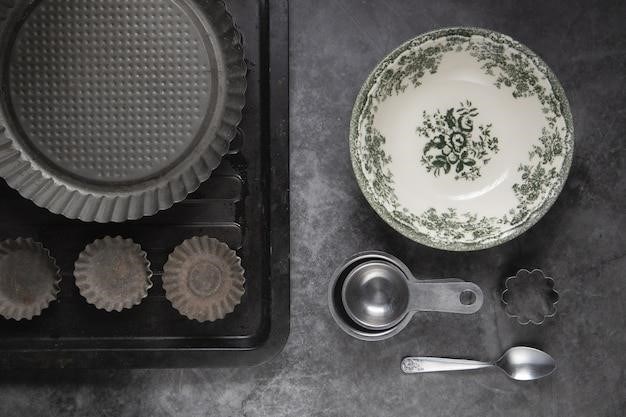
West Bend Slow Cooker Manual⁚ A Comprehensive Guide
This comprehensive guide provides a detailed overview of your West Bend slow cooker, from understanding the control panel to troubleshooting common issues. Whether you’re a seasoned slow cooker enthusiast or a novice looking for easy recipes, this manual is your ultimate resource. We’ll cover everything you need to know to get the most out of your West Bend slow cooker and create delicious meals with ease.
Introduction
Welcome to the world of effortless cooking with your West Bend slow cooker! This versatile appliance is designed to make meal preparation a breeze, allowing you to create delicious and comforting dishes with minimal effort. Whether you’re a busy professional, a family cook, or simply looking for convenient ways to prepare meals, your West Bend slow cooker is your perfect culinary companion.
Slow cookers, also known as crock pots, operate on the principle of low and slow cooking, using gentle heat to tenderize tough cuts of meat and meld flavors over extended periods. This method not only results in incredibly flavorful and succulent dishes but also frees up your time, allowing you to focus on other tasks while your meal cooks itself.
This manual will guide you through the various features and functionalities of your West Bend slow cooker, empowering you to unlock its full potential. From understanding the control panel and setting the cooking time to mastering heat settings and exploring diverse cooking techniques, we’ll equip you with the knowledge to create culinary masterpieces.
Safety Precautions
Your safety is our utmost priority. Please read and understand the following safety precautions before using your West Bend slow cooker. Adhering to these guidelines will ensure a safe and enjoyable cooking experience.
- Always unplug the slow cooker when not in use, cleaning it, or filling it with ingredients. Never leave it unattended while plugged in.
- Do not use the slow cooker near a heat source such as a stovetop, oven, or other appliances. Ensure adequate space around the unit for proper ventilation.
- Never immerse the base or cord in water or any other liquid. Clean the base with a damp cloth only.
- Always use oven mitts or pot holders when handling the hot cooking pot or lid. The slow cooker will be hot during and after use.
- Keep the cord away from heated surfaces and sharp edges to prevent damage or potential electrical hazards.
- Do not use the slow cooker for any purpose other than cooking as intended. Avoid using it for storage or other non-culinary functions.
- Supervise children and pets around the slow cooker. Keep them away from the unit while it’s in operation or plugged in.
By following these safety precautions, you can enjoy the convenience and benefits of your West Bend slow cooker with peace of mind. Remember, safety should always be your top priority when using any kitchen appliance. If you have any concerns or questions, please refer to the user manual or contact West Bend customer support.
Understanding the Control Panel
The control panel of your West Bend slow cooker is your command center for creating delicious meals. It features a user-friendly interface that allows you to adjust cooking settings with ease. Here’s a breakdown of the essential components and their functions⁚
- Program Button⁚ This button allows you to set the desired cooking time for your recipe. Simply press the Program button and use the Time button to scroll through the available options, typically ranging from 4 to 12 hours.
- Time Button⁚ This button is used in conjunction with the Program button to set the cooking time. Press the Time button to scroll through the available time options until you reach the desired cooking duration.
- Heat Setting⁚ Your West Bend slow cooker likely features five numbered heat settings, ranging from 1 to 5. Heat setting 1 is ideal for warming dinner rolls or muffins, while setting 2 is for keeping cooked foods warm. Heat settings 3, 4, and 5 are used for actual cooking, with higher settings providing faster cooking times.
- On/Off Switch⁚ This switch controls the power to your slow cooker. Turn it to the “On” position to begin cooking and to the “Off” position when finished.
- Indicator Lights⁚ Your West Bend slow cooker may have indicator lights to signal various functions. For example, a red light may indicate that the unit is on and actively heating, while a green light may signify that the cooking cycle is complete.
Familiarize yourself with the control panel’s layout and functions to confidently navigate your West Bend slow cooker’s settings. Whether you’re adjusting the cooking time, selecting the appropriate heat setting, or simply turning the unit on or off, understanding the control panel ensures effortless and successful slow cooking experiences.
Setting the Cooking Time
Setting the cooking time on your West Bend slow cooker is crucial for achieving perfectly cooked meals. The “Program” and “Time” buttons on your control panel allow you to select the ideal duration for your recipe. Here’s a step-by-step guide to setting the cooking time⁚
- Press the “Program” button. This activates the time-setting function.
- Use the “Time” button to scroll through the available time options. The available options typically range from 4 to 12 hours, allowing you to choose the cooking duration that best suits your recipe.
- Select the desired cooking time. When you reach the desired time, the display will show the selected time.
- Confirm the selection. Some models may require you to press the “Program” button again to confirm your chosen time. Consult your user manual for specific instructions.
Remember that cooking times can vary depending on the type of food you’re preparing, the amount of ingredients, and the desired level of tenderness. Always refer to your recipe for specific cooking time recommendations. It’s also a good idea to check the food’s internal temperature with a meat thermometer, especially for meats, to ensure it’s cooked to the desired level of doneness.
By mastering the art of setting the cooking time, you’ll unlock the full potential of your West Bend slow cooker and create delicious meals with consistent results.
Heat Settings Explained
Your West Bend slow cooker typically offers several heat settings, allowing you to adjust the cooking temperature to suit your specific needs. These settings provide flexibility, ensuring you can cook a wide variety of dishes to perfection. Here’s a breakdown of the common heat settings and their recommended uses⁚
- Low⁚ This setting provides a gentle, slow cooking temperature, ideal for tougher cuts of meat, stews, and hearty soups. It allows for long cooking times, resulting in tender and flavorful dishes. Low heat is perfect for recipes that require 7 to 10 hours of cooking.
- Medium⁚ This setting offers a moderate cooking temperature, suitable for a variety of dishes, including chicken, pork, and vegetables. It strikes a balance between low and high heat, allowing for quicker cooking times than low, but still ensuring tender results. Medium heat is ideal for recipes that require 4 to 6 hours of cooking.
- High⁚ This setting provides the highest cooking temperature, suitable for quick cooking or finishing dishes. It’s useful for searing meat or vegetables before transferring them to the slow cooker for a longer cooking time. High heat is best for recipes that require 2 to 3 hours of cooking.
- Warm⁚ This setting maintains a low temperature, perfect for keeping cooked food warm and ready to serve. It’s ideal for keeping leftovers or preparing dishes ahead of time.
Always consult your recipe for recommended heat settings and cooking times. Experimenting with different settings and adjusting cooking times based on your recipe and personal preferences will help you achieve the best results. Remember, slow cooking is all about patience and allowing time for flavors to meld and ingredients to become tender.
Cooking Tips and Techniques
Mastering the art of slow cooking with your West Bend slow cooker involves more than just tossing ingredients in and pressing start. Here are some tips and techniques to elevate your slow-cooked creations and ensure delicious, melt-in-your-mouth results⁚
- Start with a good sear⁚ For richer flavor and a beautiful browning, sear meats in a pan before adding them to the slow cooker. This adds depth of flavor and helps prevent the meat from becoming dry during the long cooking process.
- Layer your ingredients⁚ When assembling your dish, layer the ingredients strategically. Place the thicker items like meats or vegetables at the bottom, allowing heat to distribute evenly. Delicate ingredients like herbs and spices can be added towards the end of cooking to prevent them from overcooking.
- Don’t overfill the slow cooker⁚ Give your ingredients enough space to cook evenly. Crowding the slow cooker can prevent proper heat distribution and may result in uneven cooking.
- Adjust liquid levels⁚ Monitor the amount of liquid in your slow cooker throughout the cooking process; You may need to add more liquid to prevent your dish from becoming too dry. For a richer sauce, use broth or wine instead of water.
- Stir occasionally⁚ While slow cookers are designed for hands-off cooking, stirring your dish occasionally helps ensure even cooking and prevents ingredients from sticking to the bottom.
- Use a meat thermometer⁚ For meats, use a meat thermometer to ensure they reach the safe internal temperature. This guarantees food safety and ensures the meat is cooked to your desired level of doneness.
Remember, slow cooking is all about patience. Allow time for flavors to develop and ingredients to become tender. Experiment with different recipes and techniques, and don’t be afraid to adjust based on your personal preferences. Enjoy the journey of slow cooking and the delicious results it produces!
Cleaning and Maintenance
Keeping your West Bend slow cooker clean and well-maintained ensures its longevity and performance. Here’s a step-by-step guide to cleaning and maintaining your slow cooker⁚
- Unplug and Allow to Cool⁚ Always unplug your slow cooker from the power outlet before cleaning. Allow it to cool completely to avoid burns or damage. Never immerse the heating base in water.
- Remove and Clean the Removable Parts⁚ The stoneware pot, lid, and any other removable parts are dishwasher-safe. Wash them in warm, soapy water or place them in the dishwasher. Avoid using harsh abrasive cleaners or scrubbers that may scratch the surfaces.
- Wipe Down the Heating Base⁚ Use a damp cloth to wipe down the exterior of the heating base, focusing on any spills or food residue. You can use a mild dish soap for stubborn stains. Never immerse the heating base in water or place it in the dishwasher.
- Clean the Seal⁚ The lid’s seal is crucial for proper cooking. Wipe it down with a damp cloth and ensure it’s free of any debris. Avoid using abrasive cleaners on the seal, as they can damage it.
- Store Properly⁚ After cleaning, allow all parts to dry completely before storing them. Store the heating base in a dry, cool place. Avoid stacking heavy items on top of the slow cooker.
- Regular Maintenance⁚ To prevent mineral buildup, periodically descale your slow cooker by boiling a solution of equal parts water and white vinegar in the stoneware pot for 15 minutes. Rinse thoroughly and allow to dry completely before storing.
Following these cleaning and maintenance guidelines will help keep your West Bend slow cooker in optimal condition, allowing you to enjoy its benefits for years to come.
Troubleshooting Common Issues
While West Bend slow cookers are known for their reliability, occasional issues can arise. This section will guide you through troubleshooting some common problems you might encounter⁚
- Slow Cooker Not Heating⁚ First, ensure the slow cooker is plugged in and the power switch is turned on. Check the outlet for power using another appliance. If the outlet is working, inspect the power cord for any damage. If the cord is damaged, replace it immediately. If the slow cooker still doesn’t heat, it may require professional repair.
- Food Not Cooking Thoroughly⁚ If your food isn’t cooking to the desired temperature, try increasing the heat setting or the cooking time. Check the lid to ensure it’s properly sealed. Overcrowding the slow cooker can also hinder proper cooking. Ensure there’s enough space for heat circulation.
- Food Burning or Sticking⁚ This often occurs due to overcrowding or using too much liquid. Ensure there’s enough space for the food to cook evenly and adjust the liquid amount as needed. Stirring the food periodically can also prevent burning.
- Slow Cooker Leaking⁚ This can be due to a faulty seal or a cracked stoneware pot. Inspect the lid seal for any damage and ensure it’s clean and free of debris. If the pot is cracked, it needs to be replaced. Avoid overfilling the slow cooker, as this can cause pressure buildup and leaks.
- Strange Noises or Smells⁚ If you hear unusual noises or smell burning, immediately unplug the slow cooker and check for any potential causes. If the issue persists, contact West Bend customer service or a qualified appliance repair technician. Never operate a slow cooker that emits unusual noises or smells.
By following these troubleshooting tips, you can address most common issues and enjoy the convenience and deliciousness of your West Bend slow cooker. Remember, if the problem persists, consult a professional for assistance.

Recipes for Your West Bend Slow Cooker
The beauty of a slow cooker lies in its ability to transform simple ingredients into flavorful, comforting meals. Your West Bend slow cooker opens a world of culinary possibilities, allowing you to experiment with a wide range of recipes, from classic comfort food to exotic flavors. Here are some recipe ideas to get you started⁚
- Classic Pulled Pork⁚ A slow cooker staple, pulled pork is incredibly tender and flavorful. Season a pork shoulder with your favorite rub, add your favorite barbecue sauce, and cook on low for 6-8 hours. Serve on buns with coleslaw and pickles for a satisfying meal.
- Chicken and Dumplings⁚ This hearty, comforting dish is perfect for chilly evenings. Combine chicken, vegetables, and broth in your slow cooker, and cook on low for 4-6 hours. Add homemade or store-bought dumplings in the last 30 minutes of cooking for a warm, satisfying meal.
- Beef Stew⁚ A slow cooker is ideal for creating a rich, flavorful beef stew. Brown beef cubes before adding them to the slow cooker with vegetables, broth, and herbs. Cook on low for 6-8 hours for melt-in-your-mouth tenderness.
- Chili⁚ A classic slow cooker recipe, chili is a perfect way to use up leftover meat and vegetables. Combine ground beef, beans, tomatoes, and your favorite chili seasoning in your slow cooker. Cook on low for 4-6 hours for a hearty, flavorful meal.
- Mac and Cheese⁚ Yes, you can make mac and cheese in a slow cooker! Combine cooked macaroni, cheese sauce, and your favorite toppings in your slow cooker. Cook on low for 1-2 hours until melted and bubbly.
These are just a few ideas to spark your culinary creativity. With a little experimentation and imagination, you can create countless delicious slow cooker meals that will please everyone at the table.



